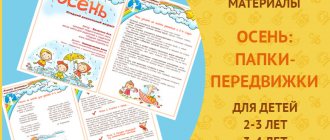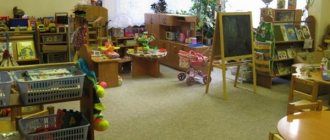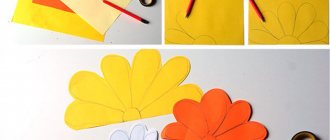What is a mixed age group
This is a group in which children differ from each other in age and development. Most often, such groups are taught in kindergartens. To create a multi-age group, it is not enough to simply gather children from 3 to 7 years old in one place. The group requires a special educational program: children study the same material, but older ones study at an in-depth level. Teachers also delegate some of the household and pedagogical tasks to the older children: the elders help the younger ones get dressed, put away the dishes, and explain tasks. Most often, multi-age education is used in kindergartens working according to the Montessori approach or within the framework of Waldorf pedagogy.
Features of the work of a teacher in a group of combined orientation
Bibliographic description:
Kuznetsova, T. D. Features of the work of a teacher in a group of combined orientation / T. D. Kuznetsova. — Text: immediate // Current tasks of pedagogy: materials of the VIII International. scientific conf. (Moscow, November 2022). - Moscow: Buki-Vedi, 2022. - pp. 55-57. — URL: https://moluch.ru/conf/ped/archive/272/13158/ (access date: 01/18/2022).
The article reveals the essence of the work of educators in a group of combined orientation, tasks, and forms of work.
Key words: educators, combined group, Federal State Educational Standard for Education, children with disabilities
The Federal State Educational Standard for Education defines one of the main tasks as “Ensuring equal opportunities for the full development of every child during preschool childhood, regardless of place of residence, gender, nation, language, social status, psychophysiological and other characteristics (including disabilities).”
Inclusive education makes it possible for children with disabilities to attend regular preschool educational institutions and be raised together with other children. The organization of the educational process for children with disabilities (hereinafter referred to as HIA) should be considered as an integral part of the federal state standards of general education.
The creation of special conditions in kindergarten for children with disabilities to receive education is associated not only with the creation of a certain material and technical base of the educational institution, but also with a change in the entire educational environment.
Healthy, normally developing children who go through inclusive education develop qualities such as sympathy, empathy, and responsiveness. They become more tolerant, which is especially important for a society with an extremely low level of tolerance. The inclusion of children with disabilities in the educational process of MBDOU changes, first of all, the attitudes of adults towards children - all children have characteristics and special educational needs.
Combined groups for children with speech impairments in preschool institutions are open with the aim of providing correctional and developmental education and education for children with normal hearing and intelligence who have deviations in speech development and providing specialized advisory, correctional and pedagogical assistance to children with speech impairments. The upbringing and education of children is built in accordance with the adapted basic educational program of the preschool institution, as well as special correctional programs that provide, along with the comprehensive development of children, the correction of defective speech development, taking into account the characteristics of the psychophysical development and individual characteristics of the child.
In combined groups for children with disabilities, a clear organization of the correction process is provided. It is provided by:
- timely examination of children;
‒ •rational scheduling of specially organized activities;
- planning subgroup and individual work;
‒ •equipping the speech therapy room with the necessary equipment and visual aids;
‒ •joint work of a speech therapist with parents, educators, and specialists.
At meetings of the kindergarten PMPc, issues of organizing work with children with developmental disorders are discussed. To work in groups of a combined orientation, educators who have completed advanced training courses are appointed, in accordance with the indications of the limitations of the pupils of these groups.
The main directions of work of the teaching staff in the combined group:
‒ monitoring the individual developmental characteristics of each child;
‒ a comprehensive assessment of the resources and deficits of a child with disabilities to draw up an individual-oriented plan and an adapted educational program;
‒ planning the educational process taking into account the individual educational needs of children in the combined group;
‒ organization of joint life activities of children in a combined group;
‒ monitoring the educational process. Throughout the entire period of training and education of children with disabilities, monitoring is carried out continuously, which makes it possible to track the effectiveness of the correctional work of teachers.
The activities of a teacher in a combined group are similar to those of a teacher in general developmental and compensatory groups and are aimed at ensuring the comprehensive development of all students in the group. Features of the organization of work of a teacher in a combined group are:
‒ planning (together with a speech therapist and other specialists) and carrying out correctional and developmental activities for pupils with disabilities;
‒ planning (together with other specialists) and organizing joint activities of all students in the group;
‒ maintaining continuity in work with other specialists in the implementation of adapted educational programs for children with disabilities;
‒ ensuring an individual approach to each pupil with developmental disabilities, taking into account the recommendations of specialists (taking into account the recommendations of each teacher: the teacher takes into account speech therapy recommendations, and the speech therapist takes into account the advice of the teacher);
‒ consulting parents (legal representatives) of children with disabilities on issues of raising a child in the family;
‒ maintaining the necessary documentation.
Together with the teacher, there is always an assistant teacher in the group, who participates in organizing routine processes and also occupies a minority of the children while the teacher is busy with the majority.
The tasks facing the teacher of the combined group:
- Providing an opportunity for children with disabilities to receive high-quality preschool education in preschool educational institutions;
- Construction of an educational program taking into account the characteristics of each child in an inclusive education environment;
- Ensuring the full maximum integration of children with disabilities into the team of ordinary preschoolers by creating a barrier-free space for the interaction of all members of the educational process;
- Organizing effective interaction with parents of pupils to create conditions for full development in preschool institutions and at home;
- Constant psychoprophylactic work with parents of healthy children and children with disabilities on the topic of creating a favorable psychological atmosphere in the group;
- Assistance to parents in the form of consultations and training in the upbringing and development of all children in the combined group;
- Motivating parents of students to actively participate in the processes of learning and development of children, showing initiative and providing assistance to teachers;
- Correctional-pedagogical, medical, psychological and social correction of the condition of children with disabilities.
During organized forms of educational activity between a teacher and children, special attention is paid to ways of organizing joint activities of children: in turns, in pairs, in subgroups, with common means of implementing a plan or a common goal of interaction. Such organizational forms of work in a combined group are frontal and group classes, as well as classes in small groups (2–3 people), and individual classes.
Carrying out the entire complex of correctional training requires combining special classes to correct speech defects with the fulfillment of general program requirements.
Subgroup and individual lessons are provided by the teacher-speech therapist. Along with this, in the afternoon, special time is allocated for the teacher to work with subgroups and individual children on speech correction according to the instructions of the speech therapist “Speech Therapy Hour”. The teacher plans his work taking into account program requirements and the speech capabilities of preschoolers, since in the process of correctional and educational work the speech capabilities of each child with disabilities are taken into account.
The goal of remedial education in combined groups is to correct the sound aspect of speech, the grammatical structure of speech and phonemic underdevelopment. Education of children with correct, clear, expressive speech (in accordance with age) with the help of special speech therapy techniques and methods; preparing students for literacy training.
The main objectives of combined groups for children with speech impairments are:
- Implementation of the necessary correction of speech disorders in preschool children.
- Prevention of violations of oral and written speech.
- Development of higher mental functions of pupils.
- Development in children of voluntary attention to the sound side of speech.
- Raising children's desire to overcome speech deficiencies and maintain emotional well-being in their adaptive environment.
- Improving the methods of speech therapy work in accordance with the capabilities, needs and interests of the preschooler.
The effectiveness of correctional and developmental work in a combined group largely depends on the continuity in the work of the speech therapist teacher and other specialists. The speech therapist interacts with teachers in different forms. This is the joint preparation of long-term work planning for the current period in all educational areas; discussion and selection of forms, methods and techniques of correctional and developmental work; equipping a developing subject space in a group room; mutual attendance and participation in integrated educational activities; joint implementation of educational activities during regime moments, weekly assignments from the speech therapist to educators. In the calendar plans of educators, at the beginning of each month, the speech therapist indicates the lexical topics for the month, an approximate vocabulary for each topic being studied, the main goals and objectives of correctional work.
The speech therapist’s weekly assignments to the educator include the following sections:
- five-minute speech therapy sessions;
- outdoor games and finger exercises;
- individual work;
‒ recommendations for the selection of fiction and illustrative material.
Literature:
- Problems of preschool education at the present stage: Issue 5. / Comp. O. V. Dybina, O. A. Yenik. / - Tolyatti: TSU, 2007.
- Project method in the activities of preschool institutions: A manual for managers and practical workers of preschool educational institutions / Author: L. S. Kiseleva, T. A. Danilina, T. S. Lagoda, M. B. Zuikova. — 3rd ed. corr. and additional - M.: ARKTI, 2005.
Key terms
(automatically generated)
: combined focus, child, combined group, group, educational process, teacher, speech disorder, kindergarten, preschool, individual work.
What are the pros and cons of different age groups?
Accelerated development
. In a mixed-age group, younger and older children help each other communicate and learn. The younger ones develop faster, catching up with the older ones. The elders learn responsibility, and also “consolidate” knowledge and skills by helping the younger ones in everyday life and with tasks.
Model of society.
A group of children of different ages more closely resembles the real world - a child already in kindergarten understands the principles of communication in real life.
Development of emotional intelligence
. In such groups, children see a huge range of emotional reactions: some are upset because of the absence of their mother, others are happy about their first victories. Children learn to empathize and develop empathy. Many gain experience of communicating with peers other than their peers, which an only child in the family cannot get.
Minimum conflicts
. Peers may have more conflicts than children of different ages. In addition, children of different ages react differently in conflict: if a three-year-old is stubborn and does not share the toy, then a six-year-old will give in to the younger one or offer another way that will suit everyone.
Difficulties in adaptation
. In groups of different ages, it is more difficult for newcomers than in groups of peers. In such groups, some of the children leave the kindergarten, and new ones arrive at the beginning of the school year. They have to integrate into the existing structure of the group and much depends not on the children themselves, but on the attention of the teachers.
Little attention from teachers
. Some educators may place too much responsibility on older children and not pay enough attention to younger ones. Or, on the contrary, pay attention only to the younger ones, thinking that the older ones will cope on their own.
How to get into a correctional group?
Getting into the correctional group of a combined kindergarten is not easy. To do this, it is not enough to sign up and wait your turn. Parents will have to go through a number of stages with their child.
First you need to make an appointment with your pediatrician. It is necessary for the doctor to examine the baby and refer him for a commission.
You will need to obtain the opinion of narrow specialists: for example, a defectologist, a neurologist, a psychologist, a surgeon and a number of other doctors. It all depends on what disorders there are in the baby’s development. Based on the conclusion, it is determined which group of mixed kindergarten the child should be enrolled in.
Usually, parents try to send their child to a preschool located near their home. But combined type kindergartens are less common than general developmental ones. In addition, some establishments may not have space. With the received conclusion, you should join the electronic queue.
To enroll your child in a mixed kindergarten, you must provide the following package of documents:
- photograph size 9x12;
- voucher issued by the education committee or recruitment commission. It should be drawn up on the basis of the conclusion and recommendations of a psychological, medical and pedagogical commission for children who have deviations in physical and mental development;
- a copy of the child's birth certificate. It is certified by the head of the educational institution based on presentation of the original. Kept in the child’s personal file;
- a statement written by the parents;
- baby's medical record;
- a copy of the parents' passport pages. Certified on the basis of the provided original.
This is an approximate list of documentation for enrolling a child in kindergarten. Combined preschool institutions may require different packages of papers. You should familiarize yourself with the list of required documentation by visiting the educational institution or by calling the administration. The recruitment of a mixed kindergarten is carried out on the basis of a federal order.
The child must meet the age category. It is determined individually by each institution. It all depends on the material and technical base and staff of the kindergarten. As a rule, a mixed educational institution accepts children who are three years old.
How to organize work in groups of different ages
Maintain age symmetry
. Mixed-age groups work effectively if they include peers for everyone. Ideally, there should be an equal number of children of each age in the group. This rarely happens in practice, but it is important that one six-year-old does not study in a group with three-year-olds. Such a group would not be considered truly diverse in age. Balance helps everyone find communication partners.
Arrange the environment
. Children of different ages have different play and learning needs. Therefore, it is important to create a developmental environment that suits everyone. The Reggio or Montessori approach is best suited for these tasks. It is zoned and children can go in small groups or individually to different corners. In the common area they can communicate with each other and play group games.
Experiment with the mode
. Most often, the daily routine suits all preschoolers at once, but the younger and older ones may not agree on small details. Younger children need a little more time to sleep, so older ones may need to be woken up later. Also, younger children need more time to dress and eat.
Learn to work in small groups
. Moreover, it is advisable to constantly change the composition of these groups, adhering to only one rule: each group should contain children of different ages. Working in small groups helps children communicate effectively. Also, in microgroups, older children better convey their experience to the younger ones.
Use rituals
. Although small group activities are effective, preschoolers should not forget that they are a group. Rituals help with this: a common circle at the end of the day, a password that must be said to enter the group, chants on the way to your site. Almost anything can be a ritual: for example, you can read fairy tales before bed, which the children choose in turn.
Pay attention to everyone
. You cannot shift responsibility to older children. It is important that everyone, both junior and senior, receives care from the teacher. Otherwise, older children gradually take on responsibility and demand power commensurate with it.
Video on the topic
Tips on how to choose a good kindergarten:
Thus, combined kindergartens consist of groups of different directions. They can accommodate average children, those with developmental disabilities, and gifted individuals. It's not easy to get into such an establishment.
You need to go through a series of doctors, get a conclusion, and stand in line. But we must remember that such institutions have many advantages. Thanks to them, a baby with certain characteristics can grow up to be a normal, full-fledged person.
I'll add a few more words...
My friend’s son ended up through an acquaintance in a kindergarten for children with visual impairments, because it was more convenient for them. The boy was used to seeing children with glasses, squints, and poor vision. And when he got into a class where there was only one boy with glasses, he could not understand why they were laughing at him, because he simply had trouble seeing...
Remember, in our Soviet childhood, at school they teased everyone who was at least in some way different from the masses: bespectacled, lop-eared, too light-skinned, and vice versa - dark-skinned, plump and thin. To be like everyone else was considered commendable. Today, the humanity of society has nevertheless increased, it seems to me. There is much less teasing in children's groups and fewer offensive nicknames are given.
Do you think I'm right? Tell us how things are going with this in your children’s classes?
If the topic of the article seemed interesting to you, share it with your friends on social networks and please subscribe to the news.
Sincerely, Tatyana Sukhikh!
By the way, I recommend reading:
We improve our skills through special training
To have the right to work as a teacher of a combined group in a preschool educational institution, you need to take courses and gain relevant additional knowledge, the presence of which must be documented. My favorite “UchMag” offers an excellent opportunity to learn and receive a training certificate on the following topics:
- “Professional competence of a teacher in the context of the implementation of the Federal State Educational Standard for Education: additional education for preschoolers with disabilities”;
- “Inclusive practice in groups of combined orientation.”
It is worth saying that you can safely trust the quality of the information that you will hear in the webinar format. All materials are strictly in accordance with the Federal State Educational Standard, the certificates of this educational portal are also legal, in the established format.
Indications for placing a baby in a combined group
If you yourself want your child with special needs to be raised and educated in a combined group, and there is one in the kindergarten, then you submit an application for admission addressed to the head. In addition, you need to bring various documents:
- Birth certificate or copy;
- Conclusions of doctors: ophthalmologist, speech therapist, neurologist, otolaryngologist, orthopedist;
- Extract from the history of the child's development;
- Recommendation from a teacher-psychologist or speech therapist at a preschool institution, if the child is already attending kindergarten.
Next, you will need to take a referral and go through a special commission, which gives an opinion on the child’s possibility of attending such a group. Usually, the Regulations on the combined group of a particular kindergarten prescribe the conditions for admitting children to this group.
Since the occupancy rate in preschool educational institutions in most regions of our country is now high, there is a practice of placing a child on a waiting list for admission to kindergarten. Therefore, I advise you to take care of collecting all kinds of certificates, etc. in advance. I know that some kindergartens have opened electronic registration for the queue. So don't leave this question to the deadline.
I also wanted to raise such a sensitive issue as the negative attitude of some parents of healthy children towards raising them together with children with disabilities. Yes, it happens that mothers directly rebel against the combined group, believing that it can harm their child.
I would like to say the following: according to the experience of my colleagues who have been working in combined groups for a long time, both sides benefit. Healthy kids, brought up in the same team with special children, become more sensitive, kind and tolerant of the shortcomings of other people. They are accustomed to perceiving their comrades with disabilities as their equals, not paying attention to any features of appearance and health.
The number of children with developmental and physical disabilities is growing every year. Therefore, the task of a civilized society is to provide such people with an equal position in all spheres of life.








